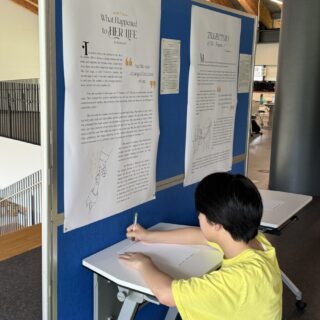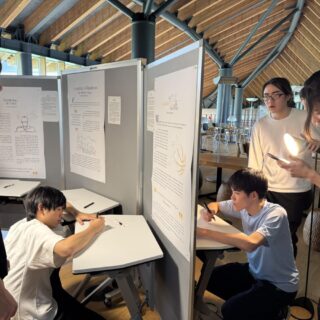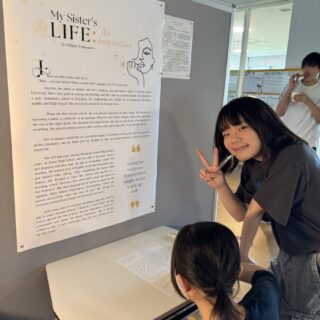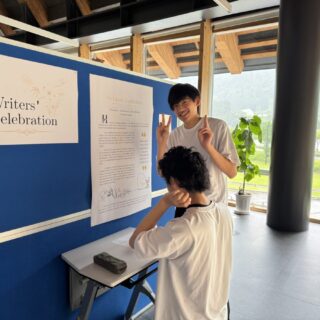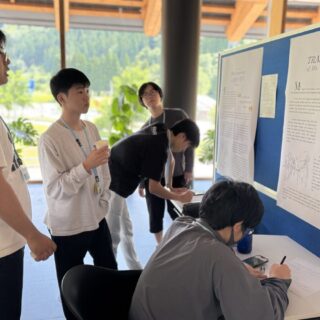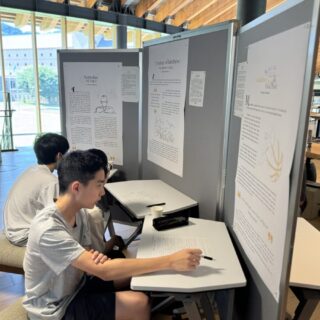English STEM
英語でSTEM
こんにちは、英語科目担当のポーリン・ベアードです。
今学期、2年生のリーディング・ライティングの授業では、学生たちが「Profile Essay」を書くために、自分にとってインスピレーションを与えてくれる人物にインタビューを行いました。家族について書いた学生も多く、メモを取りながら文章を仕上げていきました。書く過程そのものも価値あるものでしたが、最後に行われた「Writer’s Celebration」で最も重要な気づきがありました。
学生たちは、自分の作品を英語と日本語で掲示板に貼り、他の学生や教職員に披露しました。その様子を見て、私は「家族の物語を書くこと」が、学生たちが作家として、また思考する人としてのアイデンティティを育むための特別な窓(きっかけ)となることに気づきました。
また、Writer’s Celebrationを実施したことで、学生たちが英語で自然に物語を用いながら、自分の価値観を探求できることがわかりました。祖父母や両親について語る中で、共通するテーマ―「優しさ」「強靭さ」「リーダーシップ」「創造性」「感情的な強さ」―が見えてきました。ある学生は、祖父が雨の日に傘を差し出してくれたという小さな行為が、どれほど心に響いたかを語りました。これらの物語は単なる子どもの頃の思い出ではなく、世代を超えて受け継がれる教訓であり、学生自身の声で語られたものです。これを読むと、ライティングは文法や構造だけではなく、「何が大切で、なぜそれが大切なのか」を理解することでもあると改めて感じます。
発表中、学生たちは教員や他の学生たちからのコメントを誇らしげに読みました。自分の人生から生まれた文章だからこそ、彼らはその作品に強い愛着を持っていました。多くの学生が「自分は意味(価値)のある物語を語れる」という発見をし、他の学生たちも「私たちはこんなにも共通点を持っている」ということに気づきました。例えば、ある学生が母親の前向きな姿勢について書いた文章は、別の学生が父親の思いやりについて語った文章と響き合います。学生全員が互いの文章を目にする機会はそう多くありません。だからこそ、こうした共有の時間は、ライティングを皆で分かち合えるものにし、ワークシートのような問題解決学習では決して生まれない一体感を育てます。
教員にとっても、学生がどのように考え、感じ、意思決定をしているかを垣間見る貴重な機会となりました。学生が何を大切にしているのか―友情、努力、優しさ、家族―を知ることで、今後の授業づくりにも役立ちます。
Writer’s Celebrationは、単なる課題を「仲間と価値観を共有できる体験」に変えました。そのことは、学生が自分の物語を語る時、彼らは「自分は書き手である」と認識し、私たち教員も学生をより深く理解できるのです。
【Writer’s Celebration】
一般的に、執筆における成果と努力を称え、作家同士が互いに励まし合うイベントです。学生の文章を発表することで、モチベーションの維持、学びの定着、文章力向上や、仲間や学校コミュニティと喜びを共有することで達成感を高めることを目的として実施されます。
ポーリン・ベアード
Celebrating the Hearts Behind the Writing and the Community that Grows From It
Pauline Baird an English teacher at ICT.
This semester, students in the 2nd Year reading and writing class interviewed people who inspired them to write a Profile Essay. Several students wrote about family members, took field notes, and drafted profile essays. The writing process itself was valuable; however, the most meaningful insights emerged during the “Writer’s Celebration” at the end. As students shared their work on bulletin boards for the entire school to read (in English and in Japanese), I began to see how family-story writing opens a unique window into students’ developing identities as writers and thinkers.
The celebration showed that students can naturally use narrative, in English, to explore personal values. As the students shared stories about grandfathers, mothers, and fathers, common themes appeared—kindness, resilience, leadership, creativity, and emotional strength. One student described how a grandfather’s small act—an umbrella given on a rainy day—touched him deeply. These stories were more than childhood memories. They were lessons passed across generations, told in the students’ own voices. Reading them reminds us that writing is not only about grammar or structure. It is also about understanding what matters and why.
During the celebration, students read comments by teachers and others with pride. They had ownership of their writing because it came from their lives. Many discovered that they could tell a meaningful story, and their classmates discovered how much we all have in common. For example, a student’s reflection on her mother’s positive mindset might echo another student’s story about his father’s compassion. It is not often that all students get to see other students’ writing. Thus, these shared moments make writing public and build a sense of community in a school that no worksheet can create.
For teachers, the celebration offered a rare window into how students think, feel, and make decisions. We learn what our students value—friendship, hard work, kindness, and family—and this helps us shape future lessons. A writer’s celebration turned a simple assignment into a shared human experience. It reminds us that when students tell their stories, they learn to see themselves as writers, and we learn to see students a little more clearly, too.
[Writer’s Celebration]
Generally, it is an event that celebrates achievements and efforts in writing, where writers encourage one another. The purpose is to publish student-writing to maintain motivation, reinforce learning, improve writing skills, and enhance the sense of accomplishment by sharing joy with peers and the school community.
Pauline Baird
 こんにちは。白山麓高専事務室の間加田 侑里です。今回は、1年生の笹木 大暉さんがAutodesk Fusionを用いて制作した作品を紹介します。
こんにちは。白山麓高専事務室の間加田 侑里です。今回は、1年生の笹木 大暉さんがAutodesk Fusionを用いて制作した作品を紹介します。
「コンピュータスキルズⅠA(1年生)」の授業では、1年生が入学した直後からAutodesk Fusionを活用した3Dモデリング制作に取り組みます。この授業では、エンジニアにとって必要なコンピュータの基本的なスキルを学習します。笹木さんは、授業で学んだことをもとに、2ヶ月間かけて「V8エンジン」の3Dモデル制作に挑戦しました!その様子を動画で紹介します。どうぞご覧ください!
間加田 侑里
 Hello, this is Yuri Makada from the Hakusanroku Office. This time, I would like to introduce a project created by 1st year student Taiki Sasaki using Autodesk Fusion.
Hello, this is Yuri Makada from the Hakusanroku Office. This time, I would like to introduce a project created by 1st year student Taiki Sasaki using Autodesk Fusion.
In the Computer Skills IA course for 1st year students, students begin working with Autodesk Fusion to create 3D models right after entering ICT. In this class, students learn the fundamental computer skills necessary for engineers. Taiki Sasaki, a 1st year student, applied what he learned in class and spent two months creating a 3D model of a V8 engine! I've put together a video showcasing his work—please watch!
Yuri Makada
 こんにちは。昨年日本で放送されたドラマ「不適切にもほどがある!」に登場する鬼教師の小川ではなく、フレンドリーな方のハヤト・オガワです!白山麓キャンパスでは薄暗い冬の季節を迎えていますが、今学期の終わりを迎え来年度へ向けて新たな期待と目標に満ちているところです。私の経歴はプログラミングと電気通信学に関する電気工学です。設計、作成、修理したりすることを楽しんでいます。
こんにちは。昨年日本で放送されたドラマ「不適切にもほどがある!」に登場する鬼教師の小川ではなく、フレンドリーな方のハヤト・オガワです!白山麓キャンパスでは薄暗い冬の季節を迎えていますが、今学期の終わりを迎え来年度へ向けて新たな期待と目標に満ちているところです。私の経歴はプログラミングと電気通信学に関する電気工学です。設計、作成、修理したりすることを楽しんでいます。
2025年1月23日(木)、トッサ・メブサヤ先生と私が担当する「ビジネスマネジメント基礎」クラスの最終日でした。この日は、ビジネス提案の最終発表を行いました。この提案は、新たな問題点の策を見出し、学生たちが学校生活を送るにあたり役立つアイデアを3~5分間で行うピッチ形式です。学生たちは後学期授業第 5週からチームに分かれて学校生活やその周辺で直面した問題を取り上げ、解決策に取り組んできました。学生たちの考えたビジネス提案を紹介します。

最初のグループは、JR鉄道の学生割引の申請、取得、使用の手続きを改訂したいと考えました。この提案は、JR社、学生、そして書類を準備する学校事務局スタッフが対象です。現在の手続きでは時間と手間がかかってしまいます。そこで学生たちは、アプリを活用した、より効率的な解決策と確認システムを考え、またこれらはすべてJRのチケットシステムで管理する形にしました。アプリと確認システムには優れたセキュリティとユーザーID確認チェックが備わっており、学生利用者とJRの両方によって正しく使用されることが保証されるものです。また、チェックインとチェックアウトシステムを更新し、学校と連携してIDチェックや割引購入の承認を行うWebアプリケーションを作成することで、JRの既存の発券システムと改札に新しい機能を追加します。また、強力な収益モデルと持続可能なライフサイクルも提案しました。

2番目のグループは、この地域とキャンパス内に存在する大量のカメムシについてです。このグループが提案した解決策は、レーザー光源を使ってカメムシと特定された虫を焼却する小型ロボットでした。カメムシを駆除するたびに、利用者は1匹につき料金を支払うという新しい支払い発想が備わっています。この収益モデルにより、住宅所有者やロボットの利用者は会社からロボットをレンタルして、カメムシの発生を心配せずに暮らせるようになります。

3番目のグループは、カフェテリアのスタッフとの交流や、食事の準備および消費の過程にもっと関わりたいと考えていました。このグループは、ゴードン・ラムゼイの「キッチン・ナイトメアズ」(2007年アメリカで放送)という番組のコンセプトを活用し、料理のコーチを招いてメニューを一新したいと提案しました。学生たちは、カフェテリアのスタッフに提案を伝えること、興味のある料理と馴染みの味を伝えること、食べ物を通じてアイデアを共有すること、どのようなものを創り上げることができるかを考えました。そして、キッチンスタッフと様々な料理やテーマについて意見を取り入れ、新たな案を考えるワークショップのような体験を提案しました。収益モデルは、学校や会社の施設およびカフェテリアのケータリングの規模に応じて1回限りの料金となります。

4番目のグループは、居住エリアや寮内での騒音問題に取り組み、大声や騒音が発生した際の警告と、注意喚起を考えました。このグループは、各部屋の騒音ピーク時のレベルを追跡し、騒音発生者への警告と中央システムに問題とパターンを知らせる小型のデバイスを考案しました。システムとデータセットは、センサーと監視システムのレンタルとして施設管理会社へ定期販売されます。

5番目のグループは、黒板の読みにくさを解決するため、それをデジタル化する方法、そしてAIの助けを借りて読みにくい手書きのメモを解読する方法を解決したいと考えました。対象となるのは、座席の位置や目の状態により黒板が見えづらい学生です。このビジネスは学習施設への定期販売で、学生へのデジタルメディア費用を含めすべての人を対象に簡単にアクセスできるようにしたものです。
今回行ったビジネス提案は、アメリカのテレビ番組「シャークタンク」のようなビジネスピッチです。出場者は限られた時間で利害関係や投資家に魅力や有益なポイントを簡潔に伝え、製品やサービスへの投資に対する関心と信頼を得るという形式で行われました。
ハヤト・オガワ
 Hello everyone, it's your friendly teacher Hayato Ogawa unrelated to the Japanese drama, Extremely Inappropriate! It’s been a gray and dark winter here in Hakusanroku campus but the light at the end of the school year is upon us and it’s filled with new adventures and goals for the next school year! My background is in electrical engineering with programming and telecommunications. I enjoy designing, creating, fixing and tinkering.
Hello everyone, it's your friendly teacher Hayato Ogawa unrelated to the Japanese drama, Extremely Inappropriate! It’s been a gray and dark winter here in Hakusanroku campus but the light at the end of the school year is upon us and it’s filled with new adventures and goals for the next school year! My background is in electrical engineering with programming and telecommunications. I enjoy designing, creating, fixing and tinkering.
On Thursday, January 23rd, 2025, Tossa Mebusaya sensei and I held the final class in the Fundamentals of Business Management course. In the class students made their final business proposals. The proposals were a 3 to 5 minute pitch of an idea that would help develop a new awareness and help others have a better student life. The students have been working in teams from week 5 to bring awareness and resolve issues they have faced around and in school life.

The first group wanted to revise the process for requesting, acquiring and using the student discount for Japan Rail (JR) ticketing system. The target would help JR, students and the academic office staff who prepare the paperwork for this process. The current process is to acquire a student travel discount which is time consuming and frustrating. The students proposed a more direct and app-based solution and check system, all maintained in the JR ticket system. The app and check system has good security and user id confirmation checks to assure correct use by both student user and JR. This solution adds a new feature to the existing ticketing system and gates at JR by updating the check in check out system and creating a web application in conjunction with schools for ID checks and clearance for discount acquisitions. The students also proposed a strong revenue model and sustainable life cycle for the solution.

The second group brought awareness to the large amount of stink bugs in the area and on campus. This group’s proposed solution was a small robot that would incinerate the specific bug identified as a stink bug with a laser light source. With an interesting payment method where every time a stink bug is removed the user must pay per bug. With this revenue model it allows the homeowner or users to rent the robot from the company to in order to maintain a peaceful and stink free living space without the worry of stink bugs.

The third group wanted to have more interaction with the cafeteria staff and the food preparation and consumption process. This group wanted to use the Gordon Ramsay tv show called Kitchen Nightmares show concept and have a culinary coach to come in to shake up the school menu. The students wanted to see how they could be involved in communicating interest, curiosity and familiar tastes to cafeteria staff and share ideas through food. What kind of new creations would be made. The students offered a workshop like experience to update and collaborate with the current kitchen staff of different offerings and themes. The revenue model is a onetime fee dependent on catering size of the school/company facility and cafeteria.
The fourth group wanted to tackle the issue of noise in the living areas or dormitories to alert and give friendly reminders to other tenants, of loud behavior or disruptive noises being generated accidentally. They came up with a small device to keep track of peak noise levels in individual rooms and let a central system know of issues and patterns while alerting the noise maker. The system and dataset are sold to the facility management company as a subscription service and as a rental for the sensor and monitoring system.

The fifth group wanted to resolve the issues on difficulty of reading blackboard notes, how to digitize them and, with the help of AI, decipher hard to read handwritten notes. Target users were the students and people who may have a disadvantage of seeing the blackboard due to seat position or eye condition. This business would sell a subscription to the academic facility and would be included in the digital media cost to students to aid everyone and have ease of access to tools to help with studying.
This type of business proposal is similar to the American tv show Shark Tank where contestants have a very limited time to concisely hit attractive and informative points to stakeholders and investors so they gain interest and confidence in investing in a product or service. It is important to hit key points and have an open area for investors to come back to schedule another meeting to discuss more details.
Hayato Ogawa

 みなさんこんにちは。物理科目担当の伊藤 周先生とエンジニアリングデザイン科目担当の林 道大先生より、今年度も行った「ICT 3D Modeling Contest 2024」について紹介したいと思います。
みなさんこんにちは。物理科目担当の伊藤 周先生とエンジニアリングデザイン科目担当の林 道大先生より、今年度も行った「ICT 3D Modeling Contest 2024」について紹介したいと思います。
「ICT 3D Modeling Contest」は白山麓キャンパスの1・2年生を対象にした、3DCADをテーマにしたコンテストです。国際高専では1年生からAutodesk Fusionという3DCADソフトを扱います。3DCADでモデリングして、3Dプリンタでパーツを出力して授業やプロジェクトに使います。そこで学生のモデリング技術の向上を目的としてコンテストが行われました。
今回のテーマは「避難所に持っていきたいもの」としました。2024年1月1日の能登半島地震では多くの被災者が長い避難所生活を余儀なくされました。そんな状況を想像しながら何が必要かを考え、作品を作ってほしいという思いでこのテーマにしました。白山麓キャンパスの学生は夏休みの宿題として、作品を完成させて提出してくれました。複数の審査員による審査を経て、優秀賞(Excellence Award)として4名の学生が選ばれました。
4名の受賞者の作品とコメントは次の通りです。
----------------------------------------------------------------------------------------------
 2年生 武田 洋子さん
2年生 武田 洋子さん
タイトル:「シマエナガかんぱん−金平糖を添えて−」
制作時間:パッケージ約4時間 モデリング約8時間
こだわりポイント:パッケージ
小さいころに親しんだカンパンのパッケージに似せて、シマエナガバージョンのパッケージを制作しました。(裏の製品情報も改行まで忠実に作成しました。)
また本来のカンパンにいるキャラクターの色配置と似せてシマエナガを描いたところもポイントです。
モデリング
・カンパンの蓋の部分を曲げて作る際、サーフェス(*1)とシートメタル(*2)を駆使して作りました。
(方法が分からなかったので、去年のFusion講習会の時に教えていただいたフォーラムに質問したところ詳しく教えていただきました。)
・カンパンの模様は自作してそれを貼りつけて、より本物に近い質感を出せるようにがんばりました。
・パッケージをデカールで貼ろうとしたところ曲面だったため画像の一部が切れてしまいました。そこで解決策としてソリッド(*3)の周りをサーフェスで囲み、その上に二つに分けたパッケージを貼ることによってきれいに仕上げることができました。
審査員のコメント:
缶の形状や、ふたを開けたときの曲がり方など、かなり実物に似せてモデリングされています。また、テクスチャーも丁寧に制作してあり、全体的にすごくよくできていると感じました。中身の「カンパン」もシマエナガ風に作り込んであり、細部までの工夫を感じました。ただ、「カンパン」の配置に不自然さが残っていたので、今度は「物理演算」などの機能を用いて、実際の重なり方を計算することに挑戦してはどうでしょうか。
*1 サーフェス:厚みのないものをソフトウェア上で存在させ形状を表現する機能
*2 シートメタル:板状のものを曲げたり、切ったり、厚みを変えたりする機能
*3 ソリッド:立体物の中が詰まっているように表現する機能
----------------------------------------------------------------------------------------------
 2年生 沖山 琳世さん
2年生 沖山 琳世さん
タイトル:「Bag」
制作時間:2日
こだわりポイント:
今回のモデリングコンテストのテーマが「避難所に持っていきたいもの」というものだったので、日常から楽しく準備ができるリュックを目指しました。そのため、シンプルな構造で持ち運びやすさを意識しつつ、すこしユニークな顔のデザインを前面に加えることにしました。製作においては、約2日間をかけ、リュックの立体的な形状と布のような質感、際に使いやすいチャック部分に特にこだわりました。立体感を出すためにパーツごとの厚みや丸みを丁寧に調整し、リアリティを追求しました。また、Fusion初心者のため、制作中に多くの課題に直面しました。その都度、おなじみのフォーラム機能を活用し、他のユーザーさまのアドバイスを参考にすることで、分からない箇所を学びながら迅速に解決し製作することができました。こだわりぬいた作品が受賞したされたことがとてもうれしいです。
審査員のコメント:
機械系のCADが苦手な、やわらかな印象の曲面をうまくモデリングしてあると思います。少し大きめにモデリングされているファスナーですが、そのおかげで、よりかわいらしい印象になっているのかもしれません。操作で不明なことがあったときに、フォーラムへ質問して解決することもできているようで、自主的に学ぶ意欲も感じました。ファスナーが少し開いて中が見える状態が表現されていると、さらに良かったと思います。
----------------------------------------------------------------------------------------------
 2年生 中澤 琉月さん
2年生 中澤 琉月さん
タイトル:「Slim Compact Fan」
制作時間:約5時間
こだわりポイント:
私の作品のこだわりは、内部のプロペラの形です。プロペラ特有の曲がり方を表現するために三次元方向からの向きや角度、長さなどの調整を行いました。また、私が参考にした実際の製品に近づけるため、なるべくパターン性のある設計になるよう心掛けました。
審査員のコメント:
ハンディファンが折りたたまれる部分などに「ジョイント」が設定されていたり、ひねりがある「曲面」がモデリングされていたり、CADの機能を使いこなしていると思いました。また、実物を丁寧に、詳細に観察して、それをCADで表現する力も優れているようです。プロペラ等のモデリングは流体力学での解析に有用であり、今後はさらに高いレベルのCAD/CAEの機能などを使えるようになって欲しいと思います。
---------------------------------------------------------------------------------------------
 2年生 安田 萱さん
2年生 安田 萱さん
タイトル:「home extinguisher」
制作時間:6時間
こだわりポイント:
この作品のこだわりポイントは消火器の取手やピンなどの実際に操作する部分です。この部分では形として動くところをまとめてしまうのではなく、できるだけ実際のパーツごとに分けて後々合わせました。こうすることでパーツごとの隙間や影が出来ていい感じに見えるようになりました。他にも取手の部分にも時間をかけました。形やサイズ感だけではなく中が埋まっていない複雑な形を作るのが難しかったので作り方を変えたりしながら少しずつ作りました。
審査員のコメント:
実際の消火器で用いられている部品ごとにモデルが分割され、モデリングされているのが良かったです。それぞれの部品がどのように組合わされて、どのように動くことによって、消火器の機能を発揮しているのかがわかるモデルとなっていると思います。また、取っ手の形状も、よく観察して大きさや曲がり方のバランスを整えていることが伝わるモデリングだと感じました。実際に画面内で動作をシミュレートできるように「ジョイント」が設定されていると、さらに良いと思いますので、ぜひ次回は挑戦してみてください。
---------------------------------------------------------------------------------------------
審査員の総評
昨年に引き続き3Dモデリングコンテストが開催され、学生のみなさんから多数の力作の応募がありました。モデリングが難しい曲面が多くある形状だったり、テクスチャーにこだわったり、レンダリング設定もしてあったり、見ていて楽しくなるモデルが多くありました。その中でも、特に気になった作品をいくつか選出しましたので、みなさんの今後の3Dモデル制作の参考にしていただけたら良いと思います。
今年も学生の力作に驚かされたので、また来年も開催できたらと考えています。
伊藤 周
林 道大

From left, 2nd year students, Ruuna Nakazawa, Hiroko Takeda, Rinse Okiyama, and Kaya Yasuda左から、2年生 中澤 琉月さん、武田 洋子さん、沖山 琳世さん、安田 萱さん

 Meguru Ito sensei and Michihiro Hayashi sensei, who are in charge of Physics and Engineering Design classes, would like to introduce the ICT 3D Modeling Contest 2024.
Meguru Ito sensei and Michihiro Hayashi sensei, who are in charge of Physics and Engineering Design classes, would like to introduce the ICT 3D Modeling Contest 2024.
The ICT 3D Modeling Contest is a 3D CAD-themed contest for 1st and 2nd year students at the Hakusanroku Campus. ICT students begin using Autodesk Fusion 3D CAD software in their 1st year, and use 3D CAD modeling and 3D printers to output parts for use in classes and projects to improve student 3D CAD modeling skills. ICT holds a yearly competition called the ICT 3D Modeling Contest.
The theme of this year's contest was “What You Want to Bring to an Evacuation Shelter.” Many victims of the Noto Peninsula Earthquake on January 1st, 2024 were forced to live in evacuation centers for a long time. We chose this theme because we wanted students to think about what they need while imagining such a situation and creating their models. Students at Hakusanroku Campus completed and submitted their models as their summer vacation homework. After being reviewed by several judges, four students were selected as Excellence Award winners.
The following are the comments of the four students.
----------------------------------------------------------------------------------------------
2nd year student, Hiroko Takeda
Title: Hardtack and Sugar Shimaenaga (a bird called Long-Tailed Tit) Candies
Production time: about 4 hours for the package, about 8 hours for modeling
Points of particularity: package
I created a shimaenaga version of the packaging to resemble the hardtack packaging that I remember from when I was a child. (The product information on the back of the package was faithfully reproduced down to the line breaks.)
Another key point is that I drew the Striped Shimaenaga to resemble the color scheme of the character on the original hardtack.
Modeling:
・When I creating the lid part of the can, I utilized both surface(*1) modeling and sheet metal(*2) techniques. (I didn't know how to do this, so I asked a question on the forum where I learned about it during the Fusion workshop last year, and they gave me detailed instructions.)
・I created the design for the hardtack package pattern myself and applied it to achieve a more realistic texture, striving to make it as authentic as possible.
・I tried to apply the decals to the package, but the image was cut off because of the curved surface. As a solution, I enclosed the solid (*3) with a surface, and then applied the package in two parts on top of the solid.
Judges’ Comments:
The modeling closely resembles the actual can shape, including how the lid bends when opened. The textures have also been meticulously created, making the overall work very impressive. The contents, the hardtack, have been designed in the style of Shimaenaga, showcasing creative attention to detail. However, the arrangement of the hardtack appears somewhat unnatural. Next time, you could try using features like physics simulations to calculate a more realistic stacking arrangement.
(*1) Surfaces: Function to make objects without thickness exist and express shapes in software.
(*2) Sheet metal: Function to bend, cut and change the thickness of plate-like objects.
(*3) Solid: Function to express a three-dimensional object as if it were packed inside.
----------------------------------------------------------------------------------------------
 2nd year student, Rinse Okiyama
2nd year student, Rinse Okiyama
Title: Bag
Production time: 2 days
Points of particularity:
The theme of this modeling contest was “What You Want to Bring to an Evacuation Shelter,” so I aimed to create a backpack that would be fun to prepare in everyday life. Therefore, I decided to add a unique face design to the front of the backpack while keeping in mind its need for a simple structure and portability. I spent about two days in the production process, paying particular attention to the backpack's three-dimensional shape, cloth-like texture, and easy-to-use zipper. I carefully adjusted the thickness and roundness of each part to give it a three-dimensional feel and to pursue realism. Since, I am a Fusion beginner, I faced many challenges during the production. Each time, I utilized the well-known forum function and quickly solved the problems that I did not understand. By referring to the advice of other users, I was able to learn as I went along. I am very happy that my work won an award for my persistence.
Judges’ Comments:
I think the soft impression of curved surfaces, which is a weakness of mechanical CAD, was well modeled. The fasteners are modeled a little larger than usual, but this may have contributed to the prettier impression. Whenever there was something unclear in the operation, she was able to ask a question to the forum and solve the problem, and I felt that it showed her willingness to learn independently. It would have been even better if the zipper was slightly opened to show the inside.
----------------------------------------------------------------------------------------------
2nd year student, Ruuna Nakazawa
Title: Slim Compact Fan
Production time: about 5 hours
Points of particularity: The focus of my work is the shape of the internal propeller. I adjusted the direction, angle, and length of the propeller from a three-dimensional perspective in order to express the propeller's unique bend. I also tried to make the design as patterned as possible so that it would be close to the actual product I used as a reference.
Judges’ Comments:
I thought that the designer made good use of CAD functions, such as setting up “joints” for the parts where the handy fan folds up, and modeling “curved surfaces” with twists and turns. Also, she seems to have an excellent ability to carefully and in detail observe the actual objects and express them in CAD. The modeling of propellers, etc., is useful for fluid dynamics analysis, and I hope that she will be able to use even higher level CAD/CAE functions in the future.
----------------------------------------------------------------------------------------------
2nd year student, Kaya Yasuda
Title: Home Fire Extinguisher
Production time: 6 hours
Points of particularity:
The main focus of this work is the parts that actually operate the fire extinguisher, such as the handle and pins. In this part, instead of combining the moving elements into a single shape, I separated them into individual parts and later assembled them. By doing this, I was able to create gaps and shadows between the parts and make them look good. I also spent a lot of time on the handles. It was difficult to create not only the shape and size, but also a complicated shape that was not filled in, so I made it little by little, changing the way it was made.
Judges’ Comments: I liked how the model was divided and modeled for each component used in an actual fire extinguisher. I think the model shows how each part is combined and how it moves to perform the function of a fire extinguisher. I also felt that the modeling conveys that the shape of the handle was carefully observed and balanced in terms of size and bend. I think it would be even better if the “joints” were set up to actually simulate movement in the screen, so please give it a try next time.
----------------------------------------------------------------------------------------------
Judges' General Comments:
Continuing from last year, the 3D modeling contest was held again, and we received a large number of strong entries from students. Many of the models had curved surfaces, which are difficult to model, or were carefully textured or had rendering settings that made them enjoyable to look at. Among them, we have selected a few works that particularly caught our attention. we hope they will serve as a reference for everyone's future 3D model production.
We were surprised again at this year’s students excellent work, and we are looking forward to next year’s contest.
Meguru Ito
Michihiro Hayashi
 「しかし人間は自然の一部であり、自然に対する戦いは必然的に自分自身に対する戦いでもある。」
「しかし人間は自然の一部であり、自然に対する戦いは必然的に自分自身に対する戦いでもある。」
― レイチェル・カーソン
(1960年代に環境問題を告発したアメリカの生物学者)
こんにちは、STEM科目担当のガトリ・ドーサフです。
私が教員として主に焦点を置くことの一つに、学生たちの特定のトピックへの興味を育てるということがあります。そのためには、学生の生活や将来に直接関わるテーマを扱うことが重要になります。
学生たちが選択授業で生物か、それとも別の授業かを選ぶことができると知ったとき、私は課題の半分が達成したと感じました。私の授業に参加する学生はすでに、私の教える生物の授業に興味を持っているからです。残りの課題は、この貴重な機会を活かして、21世紀に私たちが直面する大きな課題について、若くて優れた学生たちに興味を持ってもらうことです。
環境問題が深刻な状況であることは既に知られています。環境科学は、学際的であり広範囲な科目です。広範囲なことが、環境科学を複雑に思える要因にもなりますが、同時に科学の希望にもなり得るのです。歴史は、実際に人類が協力すれば大きな課題も克服できることを証明しています。それではこの生物の授業で取り組んだ学習について紹介していきたいと思います。
希望は解決策の一部
環境問題について懸念すべき理由は数多くありますが、それは解決へ向けての希望がすべて失われたというわけではありません。授業の中で学生たちは、人間の知恵や工夫によって環境問題を軽減することが可能であるということを学びました。そして、地球という唯一の「Home・故郷」を守りながら、人間のニーズを満たせるような例や革新的なアイデアについて話し合いました。授業で取り上げた解決策の一部は次のとおりです。
・マイクログリッドを使用した分散型エネルギーシステム
・交通に関連する温室効果ガス排出量を削減するための自動運転車のシェアリング
・産業的畜産とは対照的な放牧動物のシステム
・海藻を使った海洋の循環を復元する
問題を理解することは解決への第一歩
授業の中で説明した概念を理解しやすくするために、さまざまなアクティビティと実験を行いました。
その中の1つは、「The Tragedy of the Commons」の概念を学ぶための漁業ゲームです。このアクティビティでは、学生たちは架空の村の住人となり、魚を捕まえるために競い合います。魚の種類ごとに値札が設定されており、ゲームの勝者は、村で一番裕福な人になることができるというゲームです。
 ゲームの進め方は以下の通りです。学生たちは30秒のターンを4回行い、それぞれ1ターンを漁期とします。各ターンで、ストロー2本にテープをつけた道具を使って魚を釣り上げます。ゲームを続けるためには、各ターンで最低でも500円稼がなければなりません。また、各ターン終了時に、残った魚のペアがそれぞれ2匹の子孫を生むことになります。
ゲームの進め方は以下の通りです。学生たちは30秒のターンを4回行い、それぞれ1ターンを漁期とします。各ターンで、ストロー2本にテープをつけた道具を使って魚を釣り上げます。ゲームを続けるためには、各ターンで最低でも500円稼がなければなりません。また、各ターン終了時に、残った魚のペアがそれぞれ2匹の子孫を生むことになります。
予想通り、最もお金を稼ごうと考えた学生たちは、最初のターンで魚をすべて釣り上げてしまいました。この結果、ゲームを続けて勝つためには、持続可能な戦略を考え、次の漁期にも十分な魚が残るようにすることが重要だと気付きました。この気付きを基に、ゲームをリセットし、1ターンからゲームをやり直し、今度は学生たちが協力して自然資源を継続することに取り組みました。環境に配慮した方法でゲームに挑むことで、学生たちは経済的にもより豊かなお金を得ることができました。
もう一つの重要な実験は、土壌塩類化実験です。学生たちは、さまざまな塩分濃度で緑豆の成長を観察しました。実験の結果から、塩分が植物や食料源に悪影響を及ぼすことが明らかとなりました。
また、生物多様性の減少の問題とそれが生態系に与える影響について理解するために、分類学(動植物の科学名のつくもの)と生態学(生物とその環境との相互作用)の研究について学びました。分類学の授業では、顕微鏡を用いて、色々な動物や植物を観察しました。生態学の授業では、教室で食物連鎖のアクティビティが行われました。このアクティビティでは、特定の栄養レベルの動物を選び黒板に貼り、協力して食物連鎖を作り上げなければなりませんでした。
科学的方法は解決への確かな方法です
学生たちは科学的手法を用いて、自分たちが選んださまざまな場所の空気の質をテストするための実験設計についてブレインストーミングを行いました。そして定性的および定量的データを話し合いました。これは、学生たちがさまざまな種類の大気汚染物質とその発生源について学ぶだけでなく、科学的手法や科学用語に慣れることにも役立ちました。
学生たち、そして私も、充実した学びでした。後学期では、最も差し迫った環境問題である気候変動に焦点を当て学んでいきます。
ガトリ・ドーサフ
 “𝘽𝙪𝙩 𝙢𝙖𝙣 𝙞𝙨 𝙖 𝙥𝙖𝙧𝙩 𝙤𝙛 𝙣𝙖𝙩𝙪𝙧𝙚, 𝙖𝙣𝙙 𝙝𝙞𝙨 𝙬𝙖𝙧 𝙖𝙜𝙖𝙞𝙣𝙨𝙩 𝙣𝙖𝙩𝙪𝙧𝙚 𝙞𝙨 𝙞𝙣𝙚𝙫𝙞𝙩𝙖𝙗𝙡𝙮 𝙖 𝙬𝙖𝙧 𝙖𝙜𝙖𝙞𝙣𝙨𝙩 𝙝𝙞𝙢𝙨𝙚𝙡𝙛.”
“𝘽𝙪𝙩 𝙢𝙖𝙣 𝙞𝙨 𝙖 𝙥𝙖𝙧𝙩 𝙤𝙛 𝙣𝙖𝙩𝙪𝙧𝙚, 𝙖𝙣𝙙 𝙝𝙞𝙨 𝙬𝙖𝙧 𝙖𝙜𝙖𝙞𝙣𝙨𝙩 𝙣𝙖𝙩𝙪𝙧𝙚 𝙞𝙨 𝙞𝙣𝙚𝙫𝙞𝙩𝙖𝙗𝙡𝙮 𝙖 𝙬𝙖𝙧 𝙖𝙜𝙖𝙞𝙣𝙨𝙩 𝙝𝙞𝙢𝙨𝙚𝙡𝙛.”
― Rachel Carson
Hello, this is Dorsaf Gatri, one of the STEM teachers at ICT.
As a teacher, one of my main focuses is to foster students’ interest in a particular topic. This would involve, amongst other things, tackling topics that have a direct influence on the students’ lives and/or future.
When I learned that students will have the opportunity to choose for themselves if they wanted to join Biology class or another class, I realized that half of the task is done: All the students in my class would already be interested in what I have to teach. What is left to do is to use this golden opportunity to introduce young, bright minds to one of the biggest challenges that is facing us in the 21st century.
It is no secret that the news about the decline of the state of our environment is worrisome, to say the least. Environmental science is an interdisciplinary subject. This might be a reason to think of it as a complicated matter. It can also be a reason for hope; history shows us that big challenges can be overcome when humans collaborate. This biology class tried to enforce the following ideas:
Hope is part of the solution:
There is a myriad of reasons to why we should be very concerned about the environment, however this does not mean that all hope to turn the tables is lost. Students were taught that human ingenuity can mitigate environmental issues. We discussed examples and possible innovative ideas to get humans needs met while preserving the only home that we know: the earth. Some of the solutions mentioned in class are:
-Decentralized energy systems using microgrids
-Shared driverless cars to reduce GHG emission related to transportation
-Grazing animals’ systems as opposed to industrial livestock
-Using seaweed to restore the overturning circulation in the oceans
Understanding the problem is the first step to the solution:
Different activities and experiments were conducted to illustrate the concepts explained in class.
One of these activities was a fishing game to explain the concept of the Tragedy of the Commons. In this activity students were part of an imaginary village and were competing against each other to catch fish. Each type of fish had a price tag. The winner of the game would be the richest person in the village.
 This is how the game is played: Students have four 30 seconds turns with each turn corresponding to one fishing season. During each of these turns, students try to catch fish using a tape attached to two straws and they must make at least 500¥ to keep playing. At the end of each term, each pair of fish will produce two offspring.
This is how the game is played: Students have four 30 seconds turns with each turn corresponding to one fishing season. During each of these turns, students try to catch fish using a tape attached to two straws and they must make at least 500¥ to keep playing. At the end of each term, each pair of fish will produce two offspring.
As expected, the students, hoping to be the richest and win, depleted all the fish in the ocean in the first round. This is when they realized that the only way to win this game is to come up with a sustainable strategy and make sure that there will be enough fish in the ocean for them to catch next season. I reset the game and the students were given another chance during which they worked together to maintain natural resources. Using an environmentally friendly approach to play, the students ended up with more financial prosperity.
Another important experiment that was conducted is the soil salinization experiment. The students monitored the growth of mung beans using different salinity levels. The results of the experiments showed clearly the adverse impact of salinity on plants and, by extension, on our food sources.
To sensitize the students to the problem of biodiversity loss and its impacts on ecosystems, they were introduced to taxonomy (the science of naming animals and plants) and ecology (the study of the interaction between the organisms and their environment). The taxonomy classes were followed by a microscopic observation of different animals and plants. The ecology classes were followed by a classroom food web activity. In this activity, the students, each representing an animal from a particular trophic level, had to draw that animal, hang it on the board and work together to create a food web.
The scientific method is the reliable way towards the solution:
The students used the scientific method to brainstorm an experimental design to test the air quality of different locations of their choice. They presented and discussed their qualitative and quantitative data. This helped the students to not only learn about the different types of air pollutants and their sources, but also to familiarize themselves with the scientific method and the scientific jargon.
The students enjoyed this class and so did I. Next semester we will laser-focus on the most pressing of environmental issues: Climate change.
Dorsaf Gatri










